 In the Beginning…
In the Beginning…
It all started in Avengers #69, in October of 1969, when long-time comic nut and (at that time) Marvel staff writer, Roy Thomas, decided that Marvel needed their own Justice League. Roy Thomas is the only comics writer that I know of who had fan letters printed in both Marvel and DC comics, and he has always been one of the most vociferous fans of the Justice Society of America – the group of pre-DC superheroes known for their battles during WWII – primarily as the All-Star Squadron (which he would bring back to the DC fold as well, during his stint as a DC writer a decade later). These characters were all brought back during the original annual Crisis issues in JLA, on a separate Earth-2 so as to amalgamate the continuities between the original JSA characters and their JLA counterparts. And that is what Thomas had in mind for a Marvel JLA, although he took the long way around to get to that point.
Thomas, who was working at Marvel at the time wanted to pay homage to the JSA characters he loved so much, so he created a team of villains called the Squadron Sinister, each one based on JLA/JSA archetypes, and had them face-off against the Avengers. And so was born the Game of the Galaxy, where the Grandmaster, one of the Elders of the Universe, a cross-universe gambler with a winning record that even Adam Prosak would be jealous of, challenged Kang to a game where the stakes were literally life and death! If Kang won, he would be able to revive his beloved Ravonna from the coma she was in, but if Kang lost, then Earth would be destroyed!
Kang selected the Avengers as his champions and the Grandmaster chose the Squadron Sinister; four super-villains whose collective power was unseen or even unheard of (beyond the realms of DC Comics, that is…). We had Hyperion, the Marvel equivalent to Superman; Nighthawk, the Marvel equivalent to Batman; Doctor Spectrum, the Marvel equivalent to Green Lantern; and Whizzer, the Marvel equivalent to the Flash. This way Thomas could pit the Avengers against the JLA without breaking copyright (although we’ve now seen several actual meetings between the Avengers and JLA, including the landmark Avengers/JLA mini-series from a couple of years back).
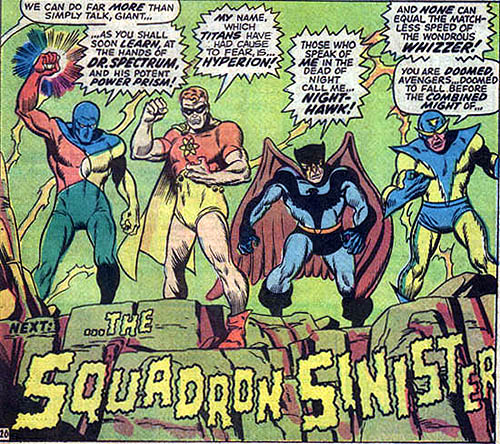
Only this JLA were villainous! Thomas thought it would be hilarious (and it was!) to have four of the foremost heroic powers in the DC Universe as super-villains in the Marvel Universe. And they proved quite the counterparts, nearly taking the combined might of the Avengers down. Unlike the Justice Society, however, these Squadron Sinister characters were from Earth (except Hyperion, who was pulled from somewhere in the Great Beyond), and would remain on Earth for some time, battling various heroes (Hyperion took on the Hulk and Thor a couple of times, Doctor Spectrum made life a living hell for Iron Man for a few issues, etc.) Eventually Hyperion went to Other-Earth and faced off against his Squadron counterpart (which I’ll explain later on). Doctor Spectrum discovered that his power prism was actually an alien who parasitically possessed him for nefarious purposes on several occasions. He’s now pretty much retired from life as Doctor Spectrum for that very reason. Nighthawk cast aside his villainry and joined the Defenders (a team of heroes, not unlike the Avengers), where he was eventually killed while valiantly saving his fellow Defenders. Whizzer became the Speed Demon, continuing his villainous ways until reforming, and joining the Thunderbolts.
Supreme Trumps Sinister
That was the first chronological introduction to the Squadron in terms of comics history, but not in terms of continuity. For, a few years later, Roy Thomas introduced his own Justice Society – the Squadron Sinister’s exact opposites, the heroes from Other-Earth of whom the Squadron Sinister were duplicated. We discovered that the Grandmaster had used the Squadron Supreme as pawns before the Game of the Galaxy took place, so when he empowered four people from our Earth, he was actually replicating super-beings who already existed.
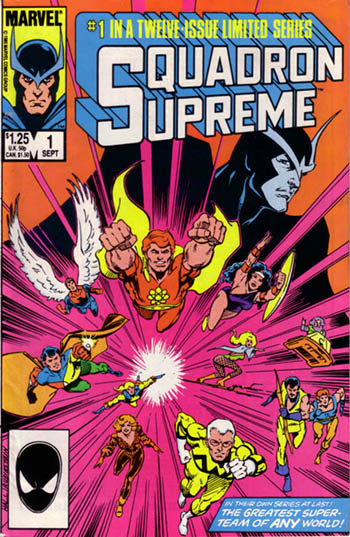
What happened behind the scenes was that in 1971, DC and Marvel decided to each create an unofficial crossover between the JLA and the Avengers. DC put together a team in JLA #87 called the Justifiers (later reformed as the Assemblers), including thunder god avatar Wandjina, Massive Man who could grow up to 20 feet tall, Tin Man who needed a chest plate to keep his heart running, brother and sister Captain Speed and the Silver Sorceress whose powers were super-speed and probability manipulation respectively, master archer The Bowman, all gift-wrapped with an English butler included for good measure. Sound similar to anyone you know?
Meanwhile, in the Avengers #85 the Squadron Supreme debuted. Although they came later than the Squadron Sinister, they’re considered as the original team, with the four villains retroactively being based on the heroes. And this time, the team was more fleshed out. The original four were there, but eight new Squadron members were introduced as well: The Wonder-Woman clone, Power Princess; Aquaman clone Amphibian; Green Arrow act-alike Hawkeye, who later became the Golden Archer and his Black Canary lady-love lookalike Lady Lark; Atom-like scientist Tom Thumb; Hawkman clone American Eagle who later became Blue Eagle and then Cap’n Hawk; Zatanna mimic Arcanna, and Firestorm doppleganger Nuke.
Aside from the new members, another aspect changed – the team that was originally meant as a joke slowly became more serious, as Roy Thomas’ protege, Steve Engleheart, began to explore the team in earnest, trying to go further than simple satire or not-so-subtle friendly criticism of his DC counterparts. The original appearance of the Squadron involved the mind-possessing Serpent Crown, which was controlling the President of their Earth, Nelson Rockefeller, who in turn was using the Squadron to control America and her resources. The Avengers traveled to the Other-Earth (in a story cheekily called ‘Crisis on Other-Earth!’) to take the Serpent Crown away from the President. The Squadron, none of whom realized the President was being controlled, initially obeyed his orders to fight the Avengers, until they convinced the Squadron that the President was under Serpent Crown’s control. They then joined the Avengers in battling the Serpent Cartel – the shadowy group behind the entire escapade – and the Avengers went back to their Earth, Serpent Crown in hand. 
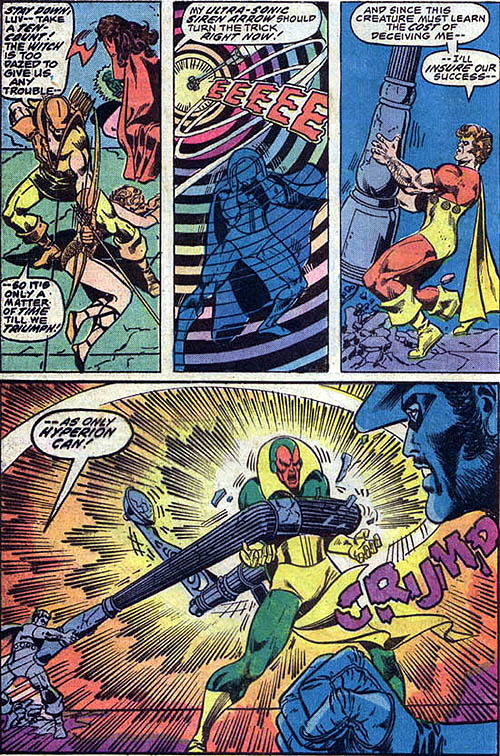
JM DeMatteis continued the transfer from parody to characterization, further reflecting the spirit of the JLA in the characters while bringing a unique flavour to the Squadron members and their Earth. After the Serpent Crown debacle, Kyle Richmond – Squadron member Nighthawk – was elected President of Other-Earth’s America, and turned the country around from the chaos it had succumbed to. And then devastation struck again – this time in the form of alien invasion. Or should I say the invasion of a single alien. But this was no ordinary alien – it was the Over-Mind, and he would be the near-downfall of the entire planet. The Over-Mind was made up of an entire race absorbed into a single alien entity. The race was the Other-Earth version of the Eternals, and Over-Mind was like the Uni-Mind of this race.* But unlike the peaceful and intellectual Eternals of Earth 616’s continuity**, this race of Eternals was savage and wanted to pillage and take over the very cosmos! So when President Kyle Richmond welcomed the Over-Mind with open arms, the Over-Mind took over Kyle’s mind, took over all of the major players in the world’s political community, turned America into a police state, and took over every major country in the world – all though the hand of Kyle Richmond, as he was under the Over-Mind’s influence. The Over-Mind then went to the Squadron’s orbiting base – Rocket Central - and single-handedly defeated the Squadron – all except for Hyperion, that is, who then barely escaped a trap set for him by Richmond; rays of deadly Argonite – the one substance that Hyperion is vulnerable to, and which could be fatal to him if provided in the correct dosage. Hyperion escaped to Earth-616 where, with the help of Dr. Strange and a hastily built teleportation device, Hyperion brought the Defenders back with him Other-Earth. 
“From Beyond the stars shall come the Over-Mind – and he shall crush the Universe!”
The epic battle took place in the early 80s, in Defenders #113-115. Over-Mind had built a nuclear arsenal on Other-Earth’s moon, preparing to wage war on other worlds in his quest for Universal conquest. The Defenders arrived and defeated an automaton Squadron Supreme (all under the Over-Mind’s control), and eventually the Over-Mind – or so they thought. Instead, they released a creature of pure evil – Null the Living Darkness – who had been working alongside Over-Mind with goal of conquest of his own. Eventually, the Defenders and the Squadron teamed up and defeated both Null and the Over-Mind, and the Defenders returned to their own Earth leaving an embattled Kyle Richmond and Squadron Supreme to pick up the pieces and try to restore order on a world in shambles.
The Utopian Dream and the Fall of the Supreme
In the mid-80s the Squadron would turn on its head. Renowned Marvel writer, Mark Gruenwald, was about to re-write how super-hero comics were written with a ground-breaking 12-issue series that would influence everything from Alan Moore’s classic Watchmen series to Warren Ellis’ neo-classic take on the Authority. It was right on the heels of DC’s Crisis on Infinite Earths, which re-wrote the entire DC Universe and its continuity – and while Gruenwald didn’t go that far, he certainly changed the face of the Squadron for all time, adding an element of darkness and shades of grey to the comics world that were never really seen in the mainstream beforehand. This series involved a questioning of morals, a look at whether or not the dream of Utopia could be a realistic possibility, and at the thin, frail line between pacifism and enforced pacifisim; between peace and contentedness, and Dystopian totalitarianism.
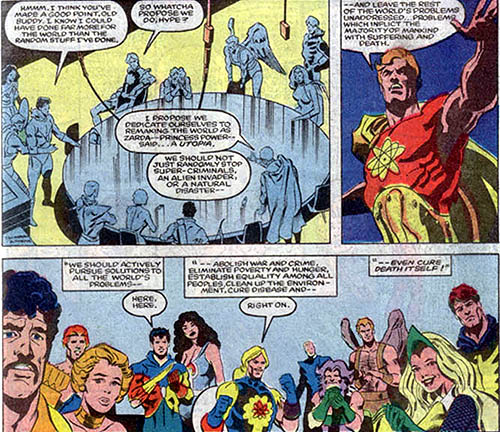
It began in the aftermath of the Over-Mind’s failed conquest. The world was a mess and Kyle Richmond was attempting to pick up the pieces. The Squadron as a whole were trying to keep order in America, from the prevention of looting, rioting and anarchy to the distribution of necessities among those who were in need***, and it was then that Power Princess reminded the assembled Supreme that she hailed from Utopia Isle, and how they lived in peace and harmony under Utopian law. The Squadron voted to create and enforce a Utopian society upon America, with the intent of solving the world’s problems by eliminating crime, war, poverty, disease, and even death. But this was much to the chagrin of Kyle Richmond, who questioned, ‘how meaningful will a Utopia be if it is a gift and not something man has earned by his own labors? What if the people will not accept the Utopia that you give them? Will you force them to take it?” Mindful of the two recent situations where society was forcibly controlled by evil elements, he resigned from the Squadron rather than take part in something that could lead to the same situation. Fashioning an Argonite bullet from a piece of the element that was bane to Hyperion (and that he kept for this very sort of situation), Kyle resigned from his presidency as well, and planned to assassinate Hyperion during the handover of the reins of the country in Capitol City, but simply could not follow through. In the true spirit of Batman, whose persona he so closely reflected, Kyle Richmond would resort to other means, as Nighthawk, to stop the madness of Project Utopia from within, using the weaknesses of the Squadron against them.
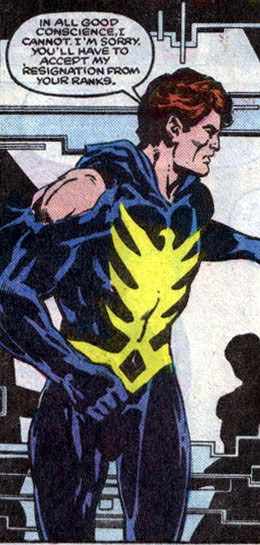
NEXT WEEK: The turning point in Squadron history and an individual look at the Squadron characters.
Questions? Queries? Comments? Send ‘em along and I’ll try to get them answered in the column! Email me at:
Kergillian (at) hotmail (dot) com
* For those who have no clue what I’m talking about, here is a very brief breakdown: There is a race of immortal beings called the Eternals (created by Jack Kirby in the 70s as a sort of Marvel version of the New Gods and Forever People, which he also created) who, due to their similarity to the Greek Gods, were often confused as them – and at one point even became sort of Earthly avatars for those very Gods. These Eternals even had similar names to Greek mythological figures: Ikaris, Sersi, Thena, etc. Their leader was Zuras, and he could bring all of the Eternals together into a single entity called the Uni-Mind, which contained the mind and physical power of every single Eternal taking part in the joining.
** Alan Moore numbered the Earth of the main Marvel continuity ‘Earth-616’, or Merlyn numbered it so in an issue of Marvel UK’s Captain Britain, written by Moore in the 80s. Nobody knows exactly why he chose this number, but my favourite explanation is thus, as quoted from Wikipedia (http://en.wikipedia.org/wiki/Earth-616):
“Many fans believed that "616" was a reference to the Number of the Beast in the…the Book of Revelation. (…) While most early manuscripts give the Number of the Beast as "666", the earliest existing fragment of the Greek text of this book gives it as "616". (…) Moore, a student of mystic esoterica from a very early age, could well have known about this alternate rendering. (…) For many years, the headquarters of DC Comics was located at 666 Fifth Avenue in New York City. Thus, the name could be a subtle joke that the DC Universe was Earth-666 while the Marvel Universe was Earth-616; both numbers, of course, are renderings of the Number of the Beast.”
*** This is perhaps particularly poignant in the aftermath of the Katrina tragedy, and a similar situation that is perhaps a case of life reflecting art taking place in New Orleans… Not to denigrate or trivialize the tragedy of those who are encountering a very real form of suffering, but sometimes even something so apparently ‘fantastic’ or ‘unbelievable’ as a four-colour superhero comic book can hold a deeper meaning in the overall scheme of things…
Also known by his screen name Kergillian, Ben Kalman has been involved in the Vs. community since day one. He started the first major online community, the Vs. Listserv, through Yahoo! Groups, and it now boasts well over 1,750 members! For more on the Yahoo! group, go to http://groups.yahoo.com/group/Marvel_DC_TCG.